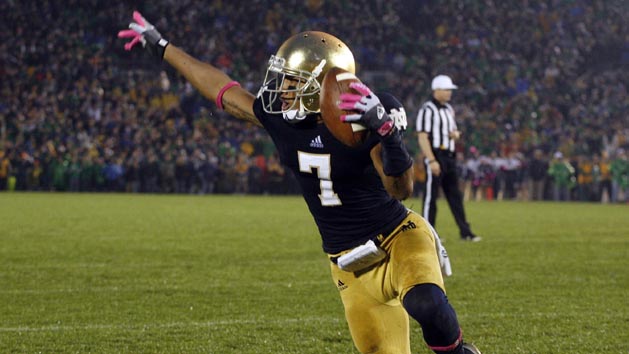
SOUTH BEND, Ind. — Leave it to the Notre Dame defense to make a stand.
The seventh-ranked Irish (6-0), who haven’t given up a touchdown since the second game of the season, stifled Stanford (4-2) when it counted in a 20-13 overtime victory Saturday.
Notre Dame’s goal-line stand shut down two tries from the 1 in overtime to seal the victory.
“When you’re talking to your team all week about a heavyweight match, and you can’t keep taking body blows, you have to stand in there, and sooner or later you’ve got to be the one that delivers,” Notre Dame coach Brian Kelly said. “That was — it comes to fruition in the way the game ended and our team coming up with a great goal-line stand. Classic.”
Stanford coach David Shaw made no apologies for his team’s two unsuccessful battering-ram shots up the middle.
“That’s who we are,” said Shaw, who didn’t even contemplate being fancy.
Tommy Rees, taking over at quarterback after Everett Golson left with a head injury, engineered a drive that tied the score, then gave the Irish the lead in overtime with a 7-yard pass to TJ Jones. The scoring strike came after Rees hit Theo Riddick with an amazing 16-yard pass on third-and-8 to set up the TD.
“TJ made a great catch,” Rees said. “Really, it was a poorly thrown ball.”
“It was thrown without much air on it,” Kelly said of the touchdown to Jones. “(Jones) did a great job.
“He’s a very skilled player this year in terms of he has focused on his craft. So he came out of
his break, came back six yards for the ball. Great receivers do that. They come back and get the
football. They don’t stand waiting for it. And that’s been his progression. He’s progressed in the
skill end of that position in his route running and that was evident in that particular play.”
Notre Dame rolled up 334 yards of offense against the Cardinal. The Irish, who have yet to yield
a rushing touchdown this season and have gone four games without giving up a touchdown on defense, allowed 272 yards.
The Irish sent the game into overtime with a Kyle Brindza 22-yard field goal with 20 seconds to
play. The 12-play, 79-yard drive was helped by a helmet-to-helmet penalty that sent Golson to the
sideline and a pass-interference call inside the Cardinal 20.
Stanford compounded Notre Dame’s problems with just over six minutes to play when Jordan
Williamson connected on a 27-yard field goal for a 13-10 lead.
After being stymied in the third quarter, the Cardinal put together a 16-play drive that ended in
the three-pointer.
It took 45 minutes and 45 seconds for Notre Dame to finally score the game’s first offensive
touchdown. Golson’s 24-yard connection to Tyler Eifert tied the score at 10 with 14:15 left in the
game.
A 23-yard hookup with Theo Riddick early in the drive was the pivotal play leading up to the pass to Eifert. That was the tight end’s third reception of the game.
A scoreless third quarter was punctuated by Notre Dame’s 114-19 yardage advantage in the quarter. However, a Golson fumble inside the Stanford 20 kept the Irish from denting the scoreboard.
Both offenses struggled through the first half. Stanford’s 10-3 lead at intermission happened
primarily because of a defensive surge that sacked Notre Dame quarterback Everett Golson in the end zone. Ben Gardner got to Golson and Chase Thomas pounced on the fumble for six points.
With six minutes to play in the first half, it was the first time all season the Irish had
trailed.
Notre Dame had two golden opportunities in the first half.
Late in the first quarter, safety Mathias Farley returned an interception 49 yards to the
Cardinal 16. Three unsuccessful plays later, Brindza kicked a 29-yard field goal.
Near the end of the first half, the Irish marched 77 yards but stalled on the Stanford 10. A 28-
yard field goal try never happened because of a high snap.
Stanford responded with an efficient 44-yard, 96-second drive that ended with a 48-yard
Williamson field goal as time expired in the half.
Notre Dame had just 106 yards of offense in the first half. Stanford, meanwhile, generated 153.
